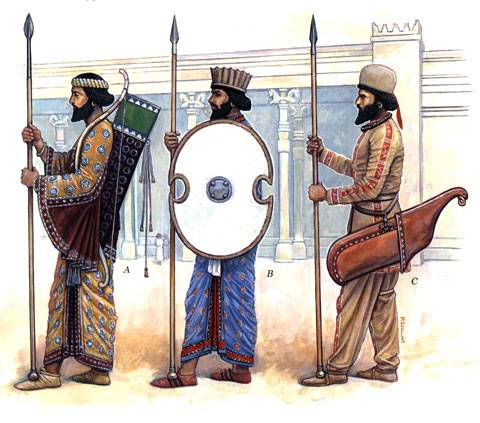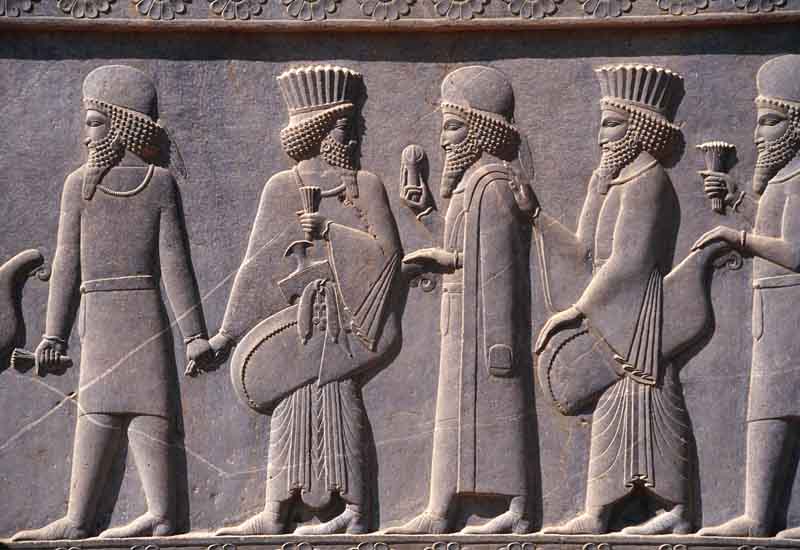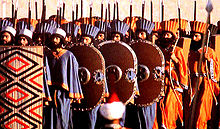300,a very controvertible film released in 2007 based on the 1998 comic series of the same name by Frank Miller. It is a fictionalized retelling of the Battle of Thermopylae however this film has caused outrage by Persians all over the world because their history,culture and heritage is being demonized and misinterpreted by a false and bias film.which is influencing thousands if not millions
of people all over the world,and destroying the reputation of on of the most tolerant and powerful
empire to have existed.
First lets have a look at
Xerxes I of Persia
also known as Xerxes the great.
Note: True Xerxes's look is drawn according sculptured reliefs on Persepolis palace.
In the film Xerxes was shown as a sadistic homosexual wearing a thong and completely covered in piercings and jewelry,and seen as a brutish monster,But from many scriptures and carvings Xerxes proved to be a tolerant and law giving man just like his predecessors,Darius the Great and The founder of human rights Cyrus the great
Persian "immortals"

ARŠTIBARA ANUSYIA ARIZANTIAN SPEAR MEN
Persian Immortals, in a ceremony in Iran of the 2,500th anniversary of the founding of the Achaemenid Empire by Cyrus the Great.
Note: True Persian look is drawn according sculptured reliefs on Persepolis palace.
The Persians clearly have been falsely shown as Africans,however Persians are of indo-European origin and in the film they are presented as ninjas wearing rags and holding two thin sword and long stretched masks clearly a prejudice attempt to make the masks look as if they would fit on an African male perfectly,thus trying to create a prejudice image against millions of black people to influence mainly white audiences to not only create tensions between Persians but to also cause division between blacks and other ethnic groups through out the us and Europe.
Facts and fiction
Fiction 1:The Spartans numbered 300
Fact:This was in fact completely false the Greeks summed up to 8000 men
Fiction 2:The Persians arrived in their millions
Fact:Garbage from Herodotus a man who claims that 2.6 million Persians fought in the battle is simply impossible,mainly due to the fact that it would only take 30.000 Persians to crush the Greeks with enough brute force, According to numerous historians (like John A. Scott, Robert Cohen, W. W. Tarn, Ernst Obst, Eduard Meyer, De Sanctis, Helmut Berve, Ulrich Wilcken, Jerry Bentley, Herbert Ziegler, Heather Streets, etc.) estimate Persian troops under 100 000, while historian Hans Delbrueck claim that the Persian fighting forces may have been as small as 15,000 to 20,000 soldiers
Fiction 3:The Persians where slaves
Fact:100% false,The Persians ruling system made it clear that Slavery was forbidden in the land of Persia,this rule links back to when Cyrus the great when he freed all the slaves from Babylon including 40000 Jews to go back to their homeland and rebuilt all their temples,all Persian workers and soldiers were hired not only from the Iranian plateau but from all around the empire from places that reached the tip of china to Asia minor and Egypt everyone had the right to to worship and express themselves rather than in Greece where if you did not believe in the Greek gods and were not Greek then you would be considered a barbarian.
Fiction 4:"Battle proved Greek bravery"
fact:you may have heard that the "heroic" Greeks had fought to the last drop of blood but this however is pure Greek euro-centrism
Out of 8000 Greek troops:
- 1 (Ephialtes) collaborated
- 400 (Thebans) surrendered
- 1900 (Spartans, helots and Thespians) killed-in-action
- 6000 (all others) escaped
Out of 8000 Greek troops:
- 1 (Ephialtes) collaborated
- 400 (Thebans) surrendered
- 1900 (Spartans, helots and Thespians) killed-in-action
- 6000 (all others) escaped
I would not have called that fighting to the death would you?
Fiction 5:Spartan women were free, Persian women were slaves
Fact:During the film the diplomat being a black male to cause discrimination to black people as well condemned the queen who spoke.but this is clearly not a Persian thing to do,keep in mind Persian woman were allowed to own and manage their own property,were allowed to get divorces and when pregnant were paid more than men,woman were also generals and high ranking peoples in the Persian empire structure.if you look at the carvings of the ancient ruins in Iran,take Persepolis for example see how they have carvings of all people in the empire holding hands and holding their own,yes their own cultural values and traditions all united in harmony and friendship,but in Greece it would have been the Greek way or the "barbarian way"

Fiction 5:Spartan women were free, Persian women were slaves
Fact:During the film the diplomat being a black male to cause discrimination to black people as well condemned the queen who spoke.but this is clearly not a Persian thing to do,keep in mind Persian woman were allowed to own and manage their own property,were allowed to get divorces and when pregnant were paid more than men,woman were also generals and high ranking peoples in the Persian empire structure.if you look at the carvings of the ancient ruins in Iran,take Persepolis for example see how they have carvings of all people in the empire holding hands and holding their own,yes their own cultural values and traditions all united in harmony and friendship,but in Greece it would have been the Greek way or the "barbarian way"
People from all over the empire ready to present gifts as kind gestures to the kings whom allowed them to pray and worship to any god they liked and gave them liberty and freedom keep their own cultures and values alive
Fiction 6: "Spartans were the best warriors ever"
Fact: some will still say that the spartans were the best warriors
Now I'll show you ALL Spartan wars and battles:
War-1. Persian War (3-0-2 victories-indecisive-defeats):1 * Thermopylae (480 BC) DEFEAT
2 * Artemisium (480 BC) DEFEAT
3 * Salamis (480 BC) Victory
4 * Plataea (479 BC) Victory
5 * Mycale (479 BC) Victory
War-2. Peloponnesian War (6-2-13):
1 * Battle of Sybota (433 BC) Indecisive
2 * Battle of Potidaea (432 BC) DEFEAT
3 * Battle of Chalcis (429 BC) Victory
4 * Battle of Rhium (429 BC) DEFEAT
5 * Battle of Naupactus (429 BC) DEFEAT
6 * Battle of Mytilene (427 BC) DEFEAT
7 * Battle of Tanagra (426 BC) DEFEAT
8 * Battle of Olpae (426 BC) DEFEAT
9 * Battle of Pylos (425 BC) DEFEAT
10 * Battle of Sphacteria (425 BC) DEFEAT
11 * Battle of Amphipolis (422 BC) Victory
12 * Battle of Mantinea (418 BC) Victory
13 * Battle of Mantinea (418 BC) DEFEAT
14 * Battle of Syme (411 BC) Indecisive
15 * Battle of Cynossema (411 BC) DEFEAT
16 * Battle of Abydos (410 BC) DEFEAT
17 * Battle of Cyzicus (410 BC) DEFEAT
18 * Battle of Notium (406 BC) Victory
19 * Battle of Mytilene (406 BC) Victory
20 * Battle of Arginusae (406 BC) DEFEAT
21 * Battle of Aegospotami (404 BC) Victory (final)
War-3. Corinthian War (2-0-3):
1 * Battle of Haliartus (395 BC) DEFEAT
2 * Battle of Nemea (394 BC) Victory
3 * Battle of Cnidus (394 BC) DEFEAT
4 * Battle of Coronea (394 BC) Victory
5 * Battle of Lechaeum (391 BC) DEFEAT
War-4. Theban War (0-0-2):
1 * Battle of Leuctra (371 BC) DEFEAT
2 * Battle of Mantinea (362 BC) DEFEAT
War-5. Cleomenean War (3-0-1):
1 * Battle of Mount Lycaeum (227 BC) Victory
2 * Battle of Ladoceia (227 BC) Victory
3 * Battle of Dyme (226 BC) Victory
4 * Battle of Sellasia (222 BC) DEFEAT (final)
Other wars battles involving Sparta (3-0-5):
1 * Battle of Sepeia (494 BC) Victory
2 * Battle of Tanagra (457 BC) Victory
3 * Battle of Phyle (403 or 404 BC) DEFEAT
4 * Battle of Munychia (403 or 404 BC) DEFEAT
5 * Battle of Piraeus (403 BC) Victory
6 * Battle of Tegyra (375 BC) DEFEAT
7 * Battle of Megalopolis (331 BC) DEFEAT
8 * Battle of Gythium (195 BC) DEFEAT
FINAL STATISTIC:
Battles:
17 victories
2 indecisive
26 defeats
History shows it that Sparta had lost 60% percent of their battles yet people still make claims that they were "invincible perfect men".
Fiction 7:"only traitors allied with the Persians"
Fact:During Greek-Persian conflict, every Greek state allied Persia except Athens and Sparta. Those Greek states include Thessaly, Boeotia, Thebes and Macedon (homeland of Alexander the Great, later conqueror of Persia). Later, during Peloponnesian war, even Sparta allied Persia! After Sparta defeated Athens with Persian help, Persians lately allied Athens against Spartans during Corinthian war. As you can see, ALL Greek states allied Persia during their ancient history.
The Persian army
A closer look on what the Persian army looked like and what tactics they used when in combat with their enemies.There be a list of renditioned Pictures showing different divisions of the Persian empire The armies of Persia are organized, trained soldiers with a combination of mobile cavalry
Anusyia
The Anusiya, roughly translating as 'companions' or 'comrades', were the Professional standing army of the Persian people, numbering always at ten thousand they were stationed in the homeland ready to be dispatched to any engagement necessary. The vast amount of experience that the Anusiya have collected on the field during the masses of engagements they have fought and won makes them a deadly foe on the field. They were recruited from the normal ranks of the Persian society, but this particular battalion was created from the most promising of the citizens. In this way only the bravest and most skilled soldiers in Persia were fighting in the Persian standing army.
ARŠTIBARA
The Arštibara were the elite of both the Persian Army and the Persian society, drawn from the aristocracy this unit was supremely loyal to the Achaemenids and the ideal of Persian supremacy. Numbering always at 2000 men this unit was usually positioned around the commanding officer of the Persians on the field. They are armed in a far more handsome manner than their lower classed brethren, with expensive robes and jewellery the Arštibara are a gleaming example of imperial might. But the image of the decadent aristocrat is shattered when the Arštibara are seen in battle at the forefront of the chaos and fighting like lions until victory. In the case of the death of their commander the Arštibara are noted to fight to the death in brave defiance of the enemy.
ARIZANTIAN SPEARMEN
The Arizanti clan are the noblest of all those in Media until Cyrus conquered media to form a Persian empire and the leading families share a common link through this heritage. They can afford far greater armaments and amour than their lower class counter parts. As such they wear a corselet of Iron scales painted gold and far more colourful garments to boot. But their lavish appearance is at a great contrast to their military skill. As Iranian aristocrats their abilities with the bow and spear are tested every day in training and hunting on the plains of Media. Their skill with the bow in particular is exceedingly impressive and can match even the honour guard of the Persians; to this end they don't carry bulky shields. In close combat they are hampered by a lack of shield but their heavy armour means they can take a good beating before needing support troops.
ARŠTIBARA ASABARI
This unit comprises of some of the greatest warriors in the ancient world. Utterly devoted to the pursuit of manly excellence these nobles vie with each other for the most glorious deeds of valour. Having practiced the art of war for the greatest part of their existence these warriors are eager to do battle with any foe and show their might.
The squadron shows the ultimate in loyalty to the King, being made up of many of his relatives and the rest being his noble's. Darayawuš the Great (Dareios) served as an Arštibara Asabari before his ascension to the Persian throne.
Armed with cornel wood palta and the characteristic golden weighted spear these soldiers can fight from a distance or up close and personal. They wear brilliant corslets of heavy scales to protect against the fiercest attacks, as such they can hold their own in even a protracted melee. Their great pride and honour prevent them from wearing any head protection however as that would be considered a cowardly and shameful act.
Riding at the head of the army in sheer brilliance these soldiers are the pride of Persia.
The squadron shows the ultimate in loyalty to the King, being made up of many of his relatives and the rest being his noble's. Darayawuš the Great (Dareios) served as an Arštibara Asabari before his ascension to the Persian throne.
Armed with cornel wood palta and the characteristic golden weighted spear these soldiers can fight from a distance or up close and personal. They wear brilliant corslets of heavy scales to protect against the fiercest attacks, as such they can hold their own in even a protracted melee. Their great pride and honour prevent them from wearing any head protection however as that would be considered a cowardly and shameful act.
Riding at the head of the army in sheer brilliance these soldiers are the pride of Persia.
Conscripts
TAKABARA

The Persians recruited a particularly ferocious Iranian tribe known to them as the Takabara for a strong offensive front, or many times used as garrison forces. They were called Takabara because of the arms which they carried, The 'Taka' is the crescent moon shaped shield which eventually many Persian units would adopt because of the better manoeuvrability afforded by its shape. The Takabara were also armed with axes capable of cleaving through bronze in the hands of the vicious Takabara tribes.
sPARABARA

The Sparabara were taken from the full members of Persian society, they were trained from childhood to be soldiers and when not called out to fight on campaigns in distant lands they practice hunting on the vast plains of Persia. However, when all is quiet and the "Pax Persica" holds true, the Sparabara return to normal life farming the land and grazing the herds. Because of this they lack true professional quality on the field, yet they are well trained and courageous to the point of holding the line in most situations long enough for a counter attack.
THANVABARA

These were the Persian archers of the Kings army. Taken from the normal ranks of Society in the same way as the Sparabara, they were also trained from childhood, but because of promise in archery directed to work in cohesion with the Sparabara as the lethal rain of arrows behind a protected wall of spears and shields. Armoured with a linen corslet and using the powerful recurved bow these archers are not to be trifled with.
They are armed with the powerful double curved bows which in the hands of the trained Persian can achieve deadly range and accuracy. Other than the bow they only carry a knife, in this way the Thanvabara should be kept out of close combat at all costs. Even thought there are noted examples of Persians without ammunition drawing their knives and charging the enemy lines, this is only a brave gesture and not a tactic to be employed by any wise commander.
They are armed with the powerful double curved bows which in the hands of the trained Persian can achieve deadly range and accuracy. Other than the bow they only carry a knife, in this way the Thanvabara should be kept out of close combat at all costs. Even thought there are noted examples of Persians without ammunition drawing their knives and charging the enemy lines, this is only a brave gesture and not a tactic to be employed by any wise commander.










No comments:
Post a Comment